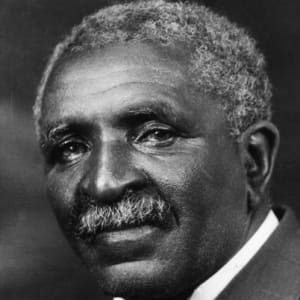You
have probably heard of George Washington Carver (1864-1943) as the
early-twentieth-century Peanut Man who developed hundreds of commercial
products from peanuts, and from other southern United States crops, in his
laboratory at Tuskegee Institute in Alabama. But these products were probably
the least important part of his work, at that time and in his legacy today. He
is also remembered as the black man who earned respect from whites who might
otherwise have dismissed blacks as an inferior, perhaps uneducable, race. I
have recently posted a video about Carver, filmed at his birthplace.
Carver
had a brilliant mind for botany and chemistry. He was also a teacher whom his
students loved, because he was humble despite his vast knowledge, and he cared
individually about each student. He wanted each student to experience
scientific discovery for themselves. While most science teachers today take
this approach, it was uncommon in Carver’s day.
The
fame was as much for his personal story as for his scientific work. He was born
into slavery just before the end of the Civil War, then kidnapped. His owner
got him back in exchange for a horse. After the war, George’s owner raised him
as one of his own children. He struggled for years to get an education from
whatever school would allow a black man to learn. He was the only black student
at Iowa State University. His mentors there wanted him to stay as a faculty
member, but instead he accepted a call from Booker T. Washington to join the
Tuskegee faculty.
For
much of his career, Carver labored in obscurity. Tuskegee president Booker T.
Washington was impatient with Carver’s disorganized approach to college duties.
Whenever Carver accomplished more, Booker T. Washington always thought of
something more that he ordered Carver to do. At one point, even though Carver
spent every waking moment working for the institute, Washington told Carver he
needed to repair the bathrooms. Washington’s regimented and disciplined
approach to everything conflicted with Carver’s slower and more thoughtful
approach.
Then
in 1921, Carver testified before the federal House Ways and Means Committee
about all the food and industrial products that could be made from peanuts. The
committee was interested because World War I had interrupted many imports into
the United States, and they wanted to know what “home-grown” products we could
have in the event of a future war. Even though these products ended up not
being marketed, the committee was very impressed with this humble and brilliant
man. From that point, Carver became a celebrity, and his fame spread worldwide.
Once
at Tuskegee, Carver showed his ability to produce excellent work with almost no
resources. Though he eventually had a lot of glassware for his teaching and
research laboratories, he had literally nothing to work with when he first
arrived. So, he found a whiskey bottle at the dump. He tied a string around the
middle. He cooled the bottle in cold water, then lit the string on fire. The
fire made the cold bottle crack in two. The top half was a funnel, the bottom
half a beaker.
By
the end of his life, Carver was receiving many prizes and worldwide
recognition. Meanwhile, in American society, the legal rights for black people
were becoming ever more restricted. After an initial period of openness after
the Civil War, southern states found ways to prevent blacks from voting, and
they ended up with almost no political voice. While Booker T. Washington and
George Washington Carver were widely admired, most white people considered them
individual exceptions from their otherwise benighted race.
Max
Otto (see previous essay) quoted Russell Lord’s “deeply disturbing” book Behold
Our Land. Lord wrote about the soil erosion, which ruined the livelihoods
of poor farmers, that was going on “under the eye of a teaching and research
staff of considerable distinction; and yet it all was, and is, by them
completely ignored. They go right on teaching their geology, their botany,
their zoology, their chemistry and physics, their archaeology, their Greek and
Latin and English, with no thought or mention of the tragic transformation of
the good green country roundabout.” Maybe Lord referred to the major
universities, but George Washington Carver was the exact opposite of this
disconnected academic lassitude.
Carver
never sought fame (though it came to him) or fortune (which he had
opportunities to refuse). He lived in a small room on the Tuskegee campus.
Books were stacked floor to ceiling in the corner. He had a display case for
his crochet work. Rocks and stalactites covered a table, and flowers crowded
his window box. His personal space reminds me of my own.
I
chose George Washington Carver as my favorite scientist in my recent book. The main reason was not so much because of his scientific research,
which was creative but not of the highest quality, as for his motivation. He
believed that scientific research at a university should prove directly helpful
to the people living around it, and to the world in general. The inspiration of
his peanut research (and also research on sweet potatoes and pecans) was to
allow poor farmers to produce value-added products, at home, that they could
sell for more money than peanuts. He also did research, and taught local
farmers, about how to preserve soil fertility, so that they could produce more
from each of their acres. This is also one of my main motivations in teaching
and research. Like Carver, I am a mediocre scientific researcher, but my heart
is in outreach to the wider community, opening their eyes to the wonders and
practical benefits of science.
All
this, despite the fact that Carver did not really follow what nearly every
scientist in his day and today would consider good scientific method. That is
the topic of the next essay.


hi
ReplyDelete